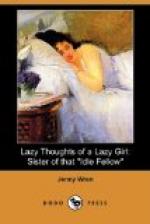The “pale young curate” type is perhaps the most general. This poor thing is so depressingly shy—I say depressingly, because his shyness affects his company. You try to draw him out. You ask question after question, and have to supply the answers yourself, only obtaining, by way of reward, despairing upward glances, that are by no means an encouragement to proceed.
The most fatal effect of this shyness, however, lies in the fact that he dare not get up to go! He sits toying with his hat, he picks up his umbrella three or four times, and lets it drop again; finally, starting up with a rush in the middle of a conversation, he hurries out, shaking hands all round with everyone but his hostess!
Would it be a very heinous breach of etiquette, if after an hour and a half of this curate’s company, one should suggest diffidently that it was time to go?
In strong contrast, there is the bold, dashing man, who only comes when he knows all the daughters are at home, not so much because it gives him pleasure to see them, as because he would not deprive them of the pleasure of talking to him. He has a faith in himself that removes mountains; no lady’s heart can beat regularly in his presence, according to his confident opinion.
So on the whole I do not think afternoon tea is so nice abroad as it is at home. It is not so pleasant with many as with a chosen few. I am selfish, I am afraid, but I must confess I enjoy mine most with the sole company of a roaring fire, a very easy chair, and a novel!
CHAPTER V.
ON DRESS.
I do not know who was the originator of the remark, but it has often been said, and is generally admitted, that women do not dress to please the men, but to outdo one another.
I think just the same might be said of men in their turn. It is after all this spirit of competition which helps to make the world go round. It is innate in man, and woman too, to always try to outrun each other.
With clothes it is undoubtedly the case. The ancient Briton must have vied with his neighbor in different designs with the woad plant. An unusual curve, an uncommon pattern, caused, I daresay, as much excitement then as the fashions of our own day.
I often wonder how they will manage some points in the histories for the coming generation. In most of these books you see illustrations and descriptions of the dress of the period, the costume of the reign. How, oh historians! can you show forth those of Victorian times? Fifty years have passed already! There were four seasons in each of those fifty years! Two hundred illustrations must be shown in order to give a correct idea of the dress of the time! Perhaps it might be more satisfactory to devote a volume exclusively to the subject.




